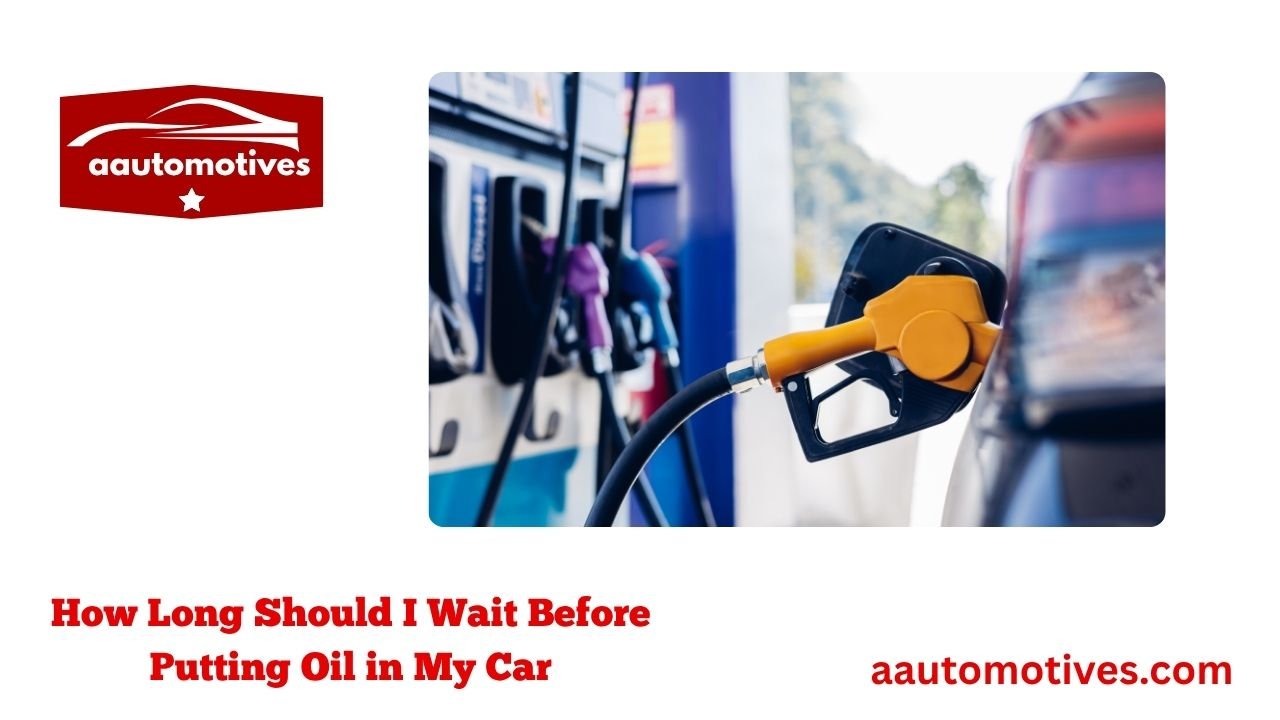How Long Should I Wait Before Putting Oil in My Car

Let me ask you something—have you ever stood in your garage, holding a bottle of motor oil, unsure if it’s the right time to pour it in? I’ve been there. The engine cools, the ticking fades, and you’re left wondering: how long should I wait before putting Oil in My Car?
It’s more than just a routine task. It’s about trust—between you and your car. Mess it up, and your engine could suffer. Do it right, and your vehicle rewards you with smooth rides and fewer mechanic visits. This article is your roadmap. A heartfelt, well-researched conversation about timing, care, and that sweet spot where your car says, “Thank you.”
Ready to turn the key on this topic? Let’s dive in.
In This Article
- 1 Why Timing Matters: It’s Not Just Oil, It’s Engine Life
- 2 After a Drive: How Hot is Too Hot?
- 3 Cold Mornings vs Hot Afternoons: The Weather Factor
- 4 The Perfect Conditions for Adding Oil
- 5 Overfilling: A Mistake That Feels Small but Costs Big
- 6 Oil Change vs Top-Up: Timing Works Differently
- 7 Signs You Shouldn’t Ignore Before Adding Oil
- 8 How Often Should You Add Oil, Really?
- 9 Synthetic vs Conventional Oil: Does It Change the Wait Time?
- 10 Real Talk: Personal Moments with My First Car
- 11 Cultural Insights: Car Care Across the World
- 12 Practical Tips That Make a Big Difference
- 13 Final Thoughts: Be Kind to Your Engine, It Carries Your Life
Why Timing Matters: It’s Not Just Oil, It’s Engine Life

The main question here—how long should I wait before putting Oil in My Car—is not just about minutes. It’s about understanding your engine’s rhythm. After you turn off your car, the engine stays hot for quite a while. That heat matters. Why? Because pouring oil into a hot engine can affect the way it circulates. The new oil can thin too fast, reducing lubrication.
Experts suggest waiting 20 to 30 minutes after turning off your engine before adding oil. That allows the metal parts to cool slightly, but not become cold. Oil poured at this time spreads evenly and sticks better.
I’ve learned this the hard way. Once, I poured oil right after driving for hours. The next day, I noticed oil spots under the car and a weird smell. Lesson learned. Let the car breathe. Let it cool. Then, pour.
After a Drive: How Hot is Too Hot?
Imagine coming back from a road trip. You pop the hood, and the heat slaps you in the face. Your engine is steaming with warmth, and your hands are sweating. This is not the moment to add oil. Trust me—I’ve tried.
Engines can reach temperatures above 200°F (93°C) after driving. That heat can cause burns, and it can also distort how new oil behaves. If you add oil when the engine is too hot, it can flash off—vaporize quickly—and reduce its effectiveness.
Here’s a quick table for visual guidance:
| Engine Condition | Wait Time Before Adding Oil |
| Just turned off after drive | 20–30 minutes |
| Cold engine (overnight) | No wait needed |
| Warm engine (short trip) | 10–15 minutes |
So, if you’re wondering how long should I wait before putting Oil in My Car after a long ride—go with 30 minutes. Use the time to clean your windshield, check tire pressure, or grab a cup of tea. Let the car rest like you do.
Cold Mornings vs Hot Afternoons: The Weather Factor
Seasons matter. Ever tried starting your car in winter? It feels stiff, like it doesn’t want to wake up. That’s how oil behaves too. On cold mornings, the oil thickens and takes time to circulate. Pouring new oil into a freezing engine can delay its movement even more.
In contrast, a hot afternoon in July might tempt you to do a quick top-up. But the oil in your car is probably already expanded. Adding more could cause an overfill—a silent killer of engines. Overfilled oil creates foam, which disrupts lubrication.
So, here’s the emotional wisdom: Treat your car like a friend. Don’t wake it up with a splash of cold oil. And don’t overload it on a summer day.
Depending on the season, the answer to how long should I wait before putting Oil in My Car changes. In winter, let your engine run idle for a bit to warm up before checking or adding oil. In summer, let it cool longer before you pour.
The Perfect Conditions for Adding Oil
Let’s paint the perfect scene. You’re parked on level ground. The engine’s been off for about 25 minutes. The air is still, not too hot, not too cold. You’ve wiped the dipstick clean, checked the oil level, and you know exactly how much you need. This is your green light moment.
Why does the surface matter? Because checking and adding oil on a slope can give false readings. And trust me, it’s easy to overfill or underfill based on a wrong dipstick reading.
Here’s a short checklist:
- Engine turned off at least 20 minutes ago
- Car is parked on level ground
- Dipstick wiped and re-inserted for accurate reading
- No visible leaks or oil spots
- Oil cap removed gently to avoid spills
That’s your ideal setup. When people ask me how long should I wait before putting Oil in My Car, I tell them: “Long enough for the engine to cool but not so long that it’s completely cold.” It’s like waiting to add spices after turning down the heat in a cooking pot. The flavors stay better. The oil works better.
Overfilling: A Mistake That Feels Small but Costs Big
Let me tell you about my friend Sam. He thought he was doing his car a favor by adding just a bit more oil, “for safety.” What happened? Two days later, he heard a knocking sound. His engine was struggling to breathe. The oil had foamed, flooded parts it shouldn’t have, and left the mechanics scratching their heads.
Overfilling is worse than running a bit low. Why? Because too much oil puts pressure on seals, foams under rotation, and can even kill your catalytic converter. You don’t want that.
The rule is simple: Know how much oil your engine takes. Check your car manual. If you’re topping up, do it slowly. Pour a little, wait a minute, check the dipstick, and repeat if needed.
In other words, the answer to how long should I wait before putting Oil in My Car isn’t just time. It’s awareness. Awareness of quantity, temperature, and timing. These three work together. Get one wrong, and your car could pay for it.
Oil Change vs Top-Up: Timing Works Differently
A full oil change and a quick top-up are different beasts. When you’re changing oil, you’re dealing with drained parts. The engine is dry. That’s why most mechanics wait 10 to 15 minutes after draining before adding new oil. It lets every last drop of the old, dirty oil leave the engine.
For a top-up, you’re just adding a small amount. That’s when timing matters more. Because the old oil is still warm, it needs time to settle so your measurement is accurate.
Let’s simplify this:
- Oil Change → Wait after draining, not before adding
- Top-Up → Wait after turning off the engine
These little distinctions matter. I learned it during a DIY oil change last year. I was too quick and ended up mixing clean oil with leftover grime. The engine sounded off for weeks. Never again.
Signs You Shouldn’t Ignore Before Adding Oil
Your car speaks in signals. You just need to listen. Ever seen the oil pressure warning light flash on your dashboard? That’s not a friendly reminder—it’s a red flag. But before jumping in with a bottle of oil, breathe. Ask yourself: “Is this an emergency, or can I wait?”
If your oil light comes on while driving, pull over safely. Let the engine sit for 10–15 minutes. Check the oil level using the dipstick. If it’s low, top up. But do it gently. Don’t overreact and overfill.
Here are a few symptoms that scream check your oil:
- Engine knocking or ticking
- Burning oil smell
- Blue exhaust smoke
- Poor fuel economy
- Oil spots under the car
All these signs mean the same thing: your engine isn’t happy. But still, the timing matters. Knowing how long should I wait before putting Oil in My Car can be the difference between a fix and a failure. Your engine needs love, not panic.
How Often Should You Add Oil, Really?
This one’s tricky. Some folks wait until a mechanic tells them. Others pour oil in like it’s coffee in a travel mug—frequently and randomly. Let’s get clear.
Most modern engines are tight and efficient. You shouldn’t need to top up oil often between changes. If you do, something’s wrong. But some engines, especially older ones, burn oil faster. For those, checking the level every 1,000 miles makes sense.
If your car is fairly new, you might only need to check once a month. But always check before long trips. Highways and hills make your engine work harder, which can lower oil levels faster than you think.
And remember: Adding oil isn’t a fix. It’s a support act. If you’re topping up often, look for leaks or internal issues.
So, next time you think about how long should I wait before putting Oil in My Car, ask this too: How often do I even need to add oil?
Synthetic vs Conventional Oil: Does It Change the Wait Time?
Ah, the age-old debate: synthetic or conventional oil? It’s like choosing between a fine wine and homemade juice. Both serve a purpose. But do they change the wait time? Not much—but they do affect engine behavior.
Synthetic oil has a higher tolerance for heat. It flows better at cold temperatures too. This means engines with synthetic oil may cool down a little faster. Still, you should wait the same 20–30 minutes before adding oil.
On the flip side, conventional oil can thicken more when cold and break down faster under heat. It needs more respect in timing.
But here’s the real insight: The type of oil you use affects your engine’s rhythm, not just its lubrication. If you switch between oil types often, your engine might need time to adapt.
No matter the oil, the golden rule remains: Let it cool, then pour. That’s the heart of the answer to how long should I wait before putting Oil in My Car—cool engines make happy oil.
Real Talk: Personal Moments with My First Car
I’ll never forget my first car—an old Honda Civic. The kind that felt like a friend more than a machine. One winter morning, I decided to top up the oil after a short drive to the grocery store. I didn’t wait. I didn’t think. I just poured.
The next week? The engine coughed like it had the flu. Took it to a local garage. The mechanic, an old guy with oil-stained hands and wisdom in his eyes, looked at me and said, “Next time, wait. Let the engine breathe.”
Since then, I’ve followed that advice religiously. Wait time is not about following rules blindly. It’s about respect. Respect for the machine that carries you every day. That moment was a turning point for me. It’s why I always remind friends who ask, “How long should I wait before putting Oil in My Car?” with a simple line—enough time for your car to thank you.
Cultural Insights: Car Care Across the World
In Japan, drivers are incredibly meticulous about engine care. They don’t just check oil levels—they check oil color, scent, and even how it moves on the dipstick. In Germany, people follow the manual with almost religious devotion. No guesswork. In rural America, car maintenance often involves whole families—father teaches son how to care for an old truck.
But the question—how long should I wait before putting Oil in My Car—transcends culture. It’s about patience, awareness, and respect.
Wherever you are, whether you’re in a bustling European city or a quiet village in Asia, your car deserves the same pause. The same breath. We may speak different languages, but our engines hum to the same rhythm.
Practical Tips That Make a Big Difference
Sometimes, small things make all the difference. Let me give you a few that have saved me over the years:
- Use a funnel when pouring oil to avoid spills.
- Buy a good dipstick cloth—microfiber works great.
- Keep oil in your trunk in case of emergencies.
- Don’t rely on dashboard lights alone—check manually.
- Track your oil top-ups in a notebook or app.
And most importantly—listen to your car. If it feels rough, sounds different, or smells strange, don’t ignore it.
When someone asks you how long should I wait before putting Oil in My Car, share these tips. They’re not just hacks. They’re little acts of love. Because caring for your car is caring for your safety.
Final Thoughts: Be Kind to Your Engine, It Carries Your Life
We all lead busy lives. But your car asks for just a few minutes—20 to 30—to cool down, rest, and get ready for what’s next. That’s not much to ask. Especially when it keeps you moving, safe, and free.
So, the next time you think about pouring oil, remember this: patience is protection. Your car isn’t just metal and wires. It’s your companion on morning commutes, weekend trips, and life’s unexpected journeys.
Take those extra minutes. Sip some coffee. Breathe. Then open that hood and pour like you mean it.
Because now, you don’t just know how long should I wait before putting Oil in My Car—you understand why it matters.






